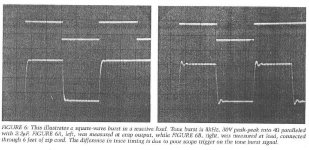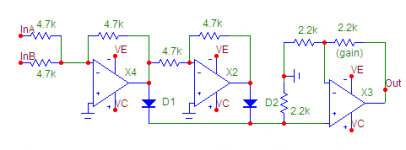Yes Jan, these stories here are funny, funny and nothing but funny. Please let me attach a step response of the 250W/4ohm power amplifier, with the evil Global Negative Feedback. 106Vp-p voltage swing.
Well I do recognise the attitude - you desperately want to make a point, any point, and your brain comes up with a background which you accept even if, on clear view, it should be clear that it is nonsense. Such is the human condition
Nice amp, btw. Too bad you had to sell your soul to the devil for it
jan
Last edited:
I'm stuck with a little stupid problem, you know how it is.
it is absolutly out of topic, but there is the place where i have more luck to find clever people
U3 sum double full wave rectifiers and amplify the rectified signal. It works fine, but the + & - signal balance is affected by he RV value, so R need to be finely tuned for each value of RV. (giving R the same value than RV, between 10K and 1Mohm)
Any idea to get rid of this without adding an other OPA ?
.... matched diodes...?
jan
Thanks for you interest, Jan..... matched diodes...?
Not a problem of threshold of diodes, but variation of impedance of the - input, depending of the RV value as i said. I can solve the problem, using an opa with fixed gain to rectify and add the two half waves, then amplify the result with variable gain, but i would like to avoid-it. Probably impossible ?
Last edited:
I won't even get started why you think a well-designed audio amp should have 5uS settling time...
jan
Jan, but we were speaking about non-resistive load (real speaker system connected to an amp).
Do you exclude completely, that settling time can be larger with real speakers?
And, speaking about settling time, I mean (maybe I am wrong) the time lag between output and input signal shapes (I refer to PMA's example). Usually, I look at 1 MHz output and input signals, adjusted to equal amplitudes at two-channel scope.
Last edited:
Thanks for you interest, Jan.
Not a problem of threshold of diodes, but variation of impedance of the - input, depending of the RV value as i said. I can solve the problem, using an opa with fixed gain to rectify and add the two half waves, then amplify the result with variable gain, but i would like to avoid-it. Probably impossible ?
Ohh I see, sorry I misunderstood, now I see.
I don't have a solution to that.
In fact, it just so happens that I will have two articles in Linear Audio Vol 5 that also address this type of issues and indeed no solution without an extra opamp I think.
Can you not just put the potmeter at the output of the last opamp to gnd, or do you need a very low source impedance there?
jan
Jan, but we were speaking about non-resistive load (real speaker system connected to an amp).
Do you exclude completely, that settling time can be larger with real speakers?
And, speaking about settling time, I mean (maybe I am wrong) the time lag between output and input signal shapes (I refer to PMA's example). Usually, I look at 1 MHz output and input signals, adjusted to equal amplitudes at two-channel scope.
No I don't exclude that, but we are back at the initial point.
This is audio, and I don't understand why you are worrying about the amp response at 1MHz?
If I exaggerate the guidance error in a typical space rocket, I can prove that it is impossible to reach the space station.
Edit: see attached - from a power amp design article I did in 1984 for Audio Amateur.
What is your conclusion here?
jan
Attachments
Last edited:
No I don't exclude that, but we are back at the initial point.
We're even further back than that- what's the settling time of the transducer? Is the amp's settling time at least an order of magnitude faster?
unfortunately, i need it-low to charge a cap fast. (Murphy was here too).I don't have a solution to that.
Can you not just put the potmeter at the output of the last opamp to gnd, or do you need a very low source impedance there?
As the error is not too big, i will forget, unsatisfied.
Thanks a lot for your help, it will save my time, not searching further.
Let me think about it. If you give me the same number of parts I suspect there's a way, particularly if we can be allowed a little common-mode swing for other opamps.unfortunately, i need it-low to charge a cap fast. (Murphy was here too).
As the error is not too big, i will forget, unsatisfied.
Thanks a lot for your help, it will save my time, not searching further.
No I don't exclude that, but we are back at the initial point.
This is audio, and I don't understand why you are worrying about the amp response at 1MHz?
If I exaggerate the guidance error in a typical space rocket, I can prove that it is impossible to reach the space station.
Edit: see attached - from a power amp design article I did in 1984 for Audio Amateur.
What is your conclusion here?
jan
Jan, 1MHz is my personal test frequency, since I build only fast amps (usually around 3MHz passband). While, average GNFB amps could be tested with 100KHz. This test is just to see, what is the mininum settling period, irrespective of load.
You example with complex load is very illustrative, since we see periodic settling process at the load, it is also present at amp's output (with less amplitude), and also at amp's input (via GNFB). Using of real speaker (electro-mecanical transducer) could make the effects indicated even bigger, and settling period even longer. Please, agree, that it is different from resistive load.
While settling distortions go on (even with small amplitude) they are summed up with input signal, and they "compete" with low-level constituents of the input signal. With NoGNFB amp, there is no such competition at input. Or, there is an intermediate case, so called current gnfb, when current-enforced input signal is summed with NFB signal at low impedance point.
Last edited:
the solution i have found, for the moment, is to set a 20K potentiometer between the output and ground, and a 18K serial resistance from the cursor to the - input. It reduce the variation of the Z in acceptable limits, and still feat in the gain range i can accept. Fast'n dirty.Let me think about it. If you give me the same number of parts I suspect there's a way, particularly if we can be allowed a little common-mode swing for other opamps.
Last edited:
You can't be that old George! You would have to be in your 90's at least I would think.
I did my military duty from 1981 to 1983 . This was one of the guns we had to be trained to operate in the test field. Extreme test for ears impulse amplitude control and acoustic perception settling time
George
While settling distortions go on (even with small amplitude) they are summed up with input signal, and they "compete" with low-level constituents of the input signal. With NoGNFB amp, there is no such competition at input. Or, there is an intermediate case, so called current gnfb, when current-enforced input signal is summed with NFB signal at low impedance point.
OK, one more time: there is NO musical signal that will trigger settling time issues in a competently designed amplifier.
jan
Vladimirk,
My question for you is may seem silly but not really. Rather than try and produce an amplifier that needs to have such an extremely wide band and speed that you are testing into a reactive load at the 1 MHz level, why would you not spend some time with the real speaker loading in question and correct the load problem? By placing a conjugate network on the speaker terminals you could correct the impedance rise and flatten the impedance rise and correct for the reactive loading. Wouldn't this be a better solution for both the phase response of the speaker system and the matching of speaker crossover points than trying to correct something like this in an amplifier. The Gbnf of the amplifier would be much happier driving a resistive load rather than the reactive loading and you would correct the speakers output at the same time. I don't understand why more designers do not think in an integrated system fashion rather than trying to correct something or allow for a situation that a good overall system designer should do?
My question for you is may seem silly but not really. Rather than try and produce an amplifier that needs to have such an extremely wide band and speed that you are testing into a reactive load at the 1 MHz level, why would you not spend some time with the real speaker loading in question and correct the load problem? By placing a conjugate network on the speaker terminals you could correct the impedance rise and flatten the impedance rise and correct for the reactive loading. Wouldn't this be a better solution for both the phase response of the speaker system and the matching of speaker crossover points than trying to correct something like this in an amplifier. The Gbnf of the amplifier would be much happier driving a resistive load rather than the reactive loading and you would correct the speakers output at the same time. I don't understand why more designers do not think in an integrated system fashion rather than trying to correct something or allow for a situation that a good overall system designer should do?
In red, the 'objectivists', in black, the 'audiophiles', in the middle, J.C.
Never talk about Fight Club.
Friends,
Just got word that Ed Dell, the man who started Audio Amateur, Glass Audio, Speaker Builder and later AudioXpress died earlier this week. Ed just turned 90 two weeks ago.
Another loss for the diy community. Ed probably did more for the audio hobby then anybody else.
I had the privelige to meet him a few times, last a few years ago when I interviewed him.
jan
Just got word that Ed Dell, the man who started Audio Amateur, Glass Audio, Speaker Builder and later AudioXpress died earlier this week. Ed just turned 90 two weeks ago.
Another loss for the diy community. Ed probably did more for the audio hobby then anybody else.
I had the privelige to meet him a few times, last a few years ago when I interviewed him.
jan
A lot of work now goes into protecting the hearing of servicemen (and women), not brought on by altruism, but the fear of being sued.I did my military duty from 1981 to 1983 . This was one of the guns we had to be trained to operate in the test field. Extreme test for ears impulse amplitude control and acoustic perception settling time
- Status
- Not open for further replies.
- Home
- Member Areas
- The Lounge
- John Curl's Blowtorch preamplifier part II

